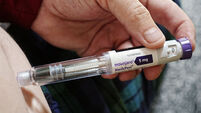‘Dream’ Boeing set for take off
Boeing says the revolutionary carbon fibre design will hand 20% fuel savings to airlines and give passengers a more comfortable ride with better cabin air and large, electronically dimmable windows.
The first $200 million (€148m) aircraft was handed over to Japanese carrier All Nippon Airways, three years behind schedule after persistent delays that cost Boeing billions of dollars.
“It took a lot of hard work to get to this day,” said Scott Fancher, vice-president and general manager of the 787 programme, at the outset of two days of celebrations at the plane’s Seattle production plant.
The long-range aircraft, which boasts a graceful new design with raked wing tips, will leave for Japan today and enter service domestically on October 26.
Boeing has taken orders for 821 Dreamliners, which will compete with the future Airbus A350, due in 2013.
The much-anticipated handover came a week after another major first delivery — the 747-8 Freighter — was abruptly postponed in a contract dispute with the customer.
ANA, the world’s ninth largest airline by revenues, plans to coax the airplane into service on domestic routes before putting it on longer international routes.
The aircraft goes 52% further than the all-metal Boeing 767 which it is designed to replace while using 20% less fuel for the distance flown, an ANA executive said.
In a classic roll of the dice in the high-stakes aerospace industry, Boeing abandoned plans for a sound barrier-chasing “Sonic Cruiser” a decade ago and worked on lighter long-range jets as cash-starved airlines valued efficiency over speed.
The resulting composites-based technology proved popular with airlines, forcing Airbus to turn its back on the aluminum airframe for its next generation of jets.
Boeing expects this to become the standard for future passenger planes.
“Technology will only get more efficient and lighter,” said the 787 programme’s chief project engineer, Mike Sinnett.
The plane’s lighter weight allows airlines to operate routes even when the demand is insufficient for larger aircraft like the Boeing 777 or 747, or the Airbus 380 superjumbo.
“For aviation we believe this is as important as the 707 was with the introduction of the jet age,” Fancher said.
He moved to head off any fears over the new materials, stressing tough composites were nothing like ordinary plastic.
“Plastic is what you have on the dashboard of your car. This is not plastic,” he said.
The 787 development programme has been delayed seven times due to challenges with engineering, supply-chain glitches and a 58-day labour strike in 2008.
“We have been waiting for the 787 for over three years as we expected it in the summer of 2008,” said senior vice-president Satoru Fujiki who took part in negotiations to buy the 787.
“I can’t say the delayed delivery didn’t have any impact but ANA and Boeing worked closely to mitigate it,” he said.














